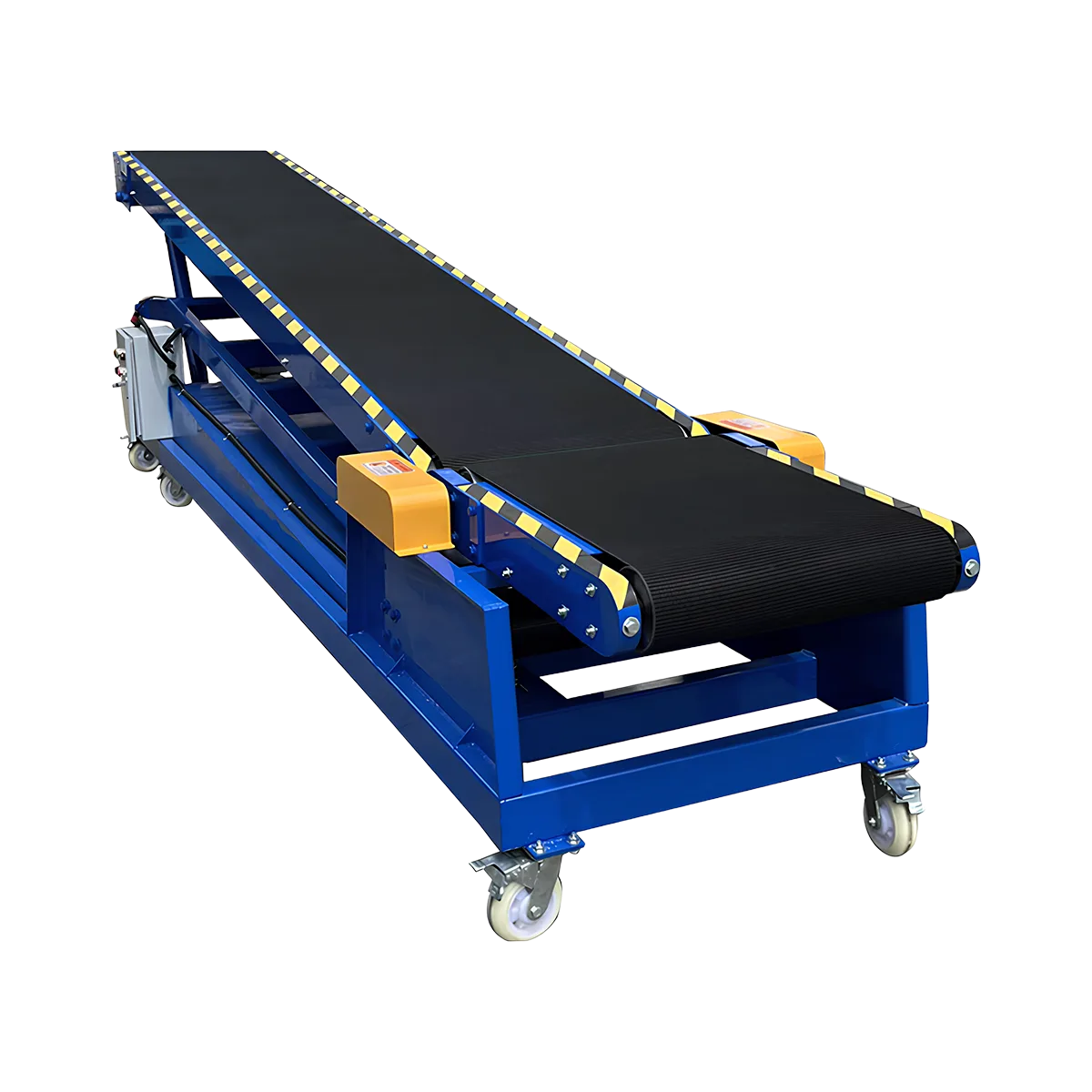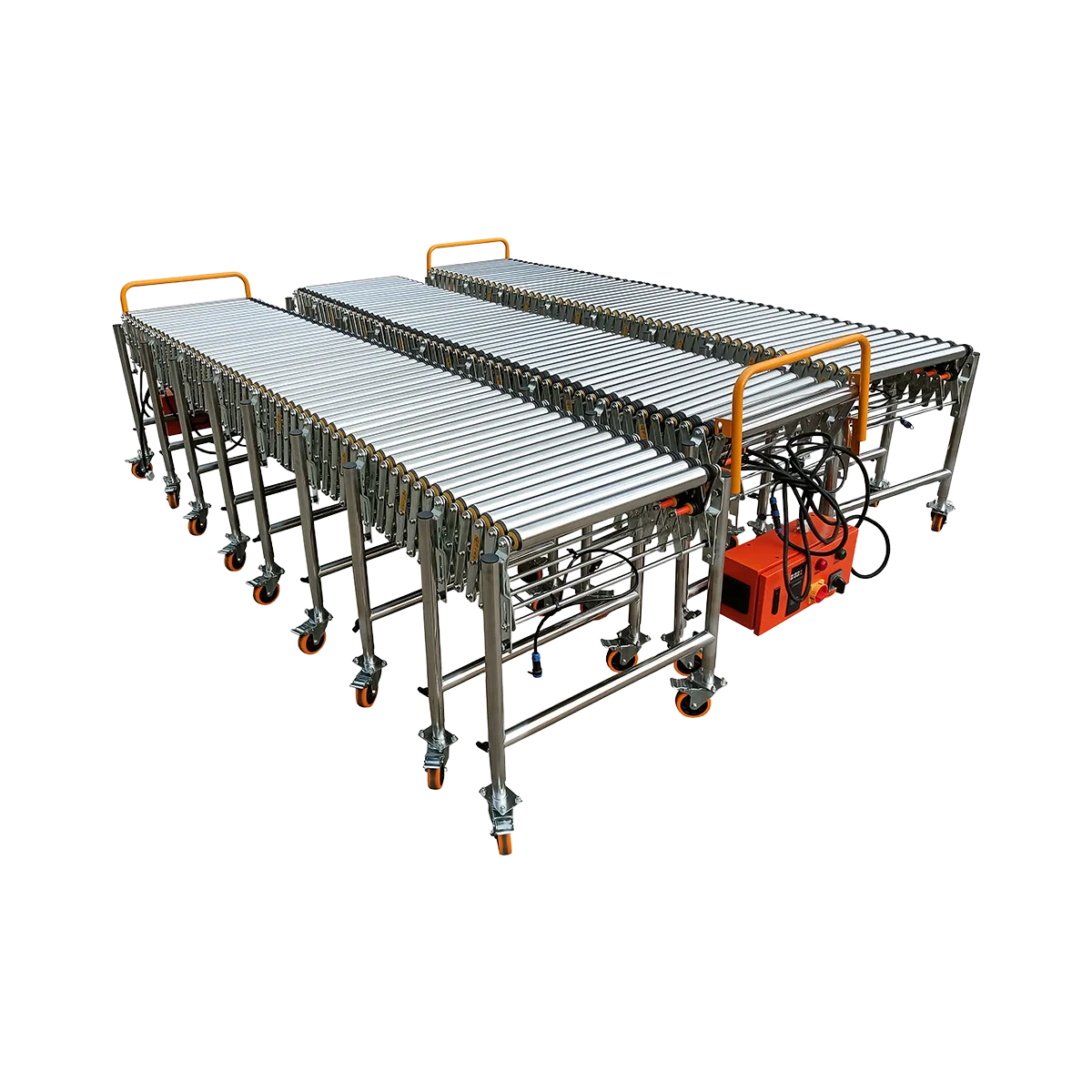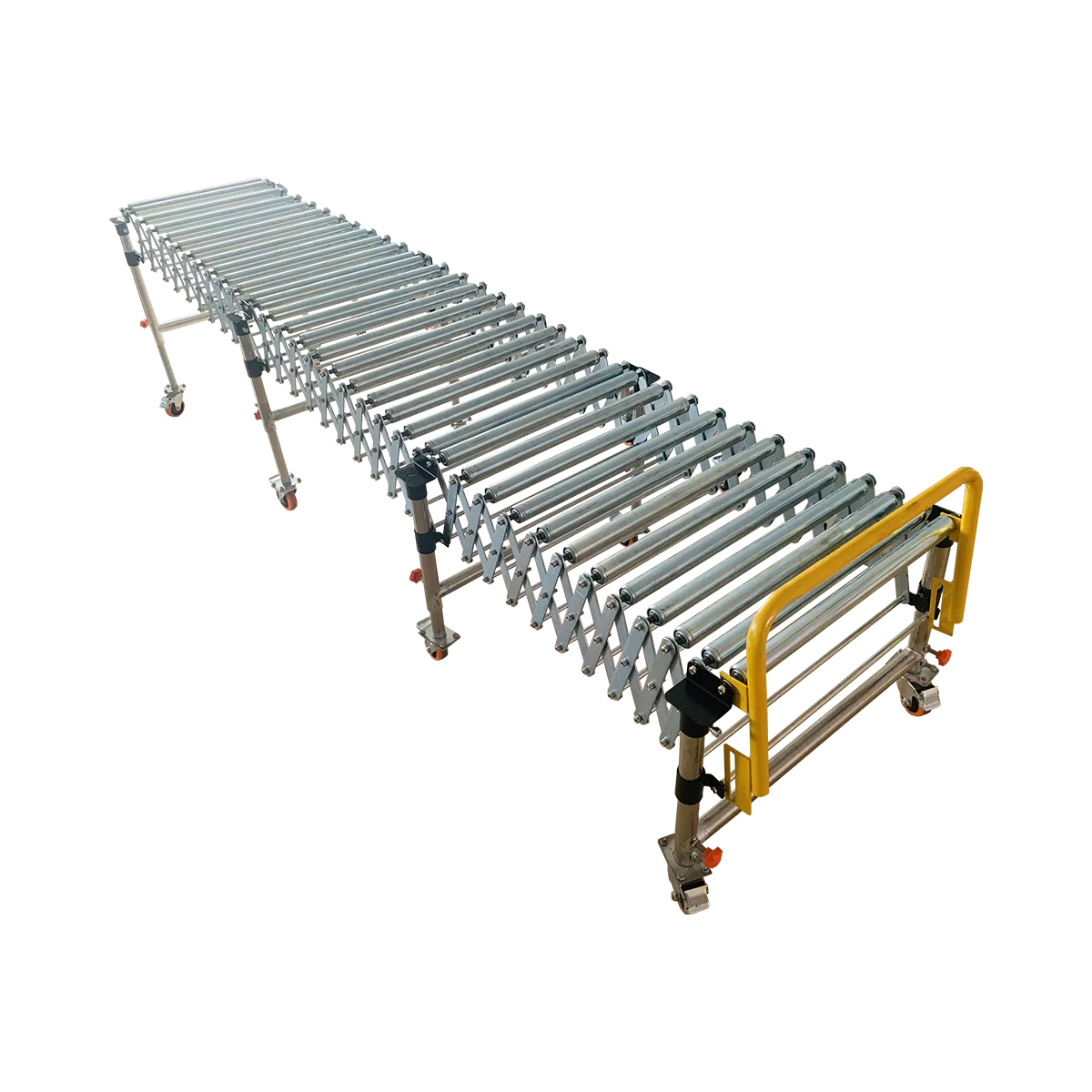How to Load and Unload Flat-Pack Furniture with a Mobile Conveyor System
Learn how a flat-pack furniture conveyor system can transform your ground-level loading operations, reducing strain and damage when handling IKEA-style boxes.
Related Products
-
Hydraulic Conveyor – Large – 7900 mm LengthCollapsed LengthExtended LengthLoad Capacity
80 kg/m
Applicable GoodsFlat-bottomed Goods
Bagged Goods
-
Hydraulic Conveyor – Medium – 7000 mm LengthCollapsed LengthExtended LengthLoad Capacity
80 kg/m
Applicable GoodsFlat-bottomed Goods
Bagged Goods
-
Powered Roller Conveyor – Multi-wedge Belt Driven – 2000 mm/SectionCollapsed Length
700 mm
Extended Length2000 mm
Load Capacity100 kg/m
Applicable GoodsFlat-bottomed Goods
-
Powered Roller Conveyor – Multi-wedge Belt Driven – 3000 mm/SectionCollapsed Length
1050 mm
Extended Length3000 mm
Load Capacity80 kg/m
Applicable GoodsFlat-bottomed Goods
-
Gravity Roller Conveyor – Roller Diameter 38 mm – 1700 mm/SectionCollapsed Length
485 mm
Extended Length1700 mm
Load Capacity50 kg/m
Applicable GoodsFlat-bottomed Goods
Bagged Goods
Flat-pack furniture presents unique material handling challenges that standard loading equipment often fails to address effectively. These packages are typically long, heavy, and awkwardly shaped, making them difficult to carry manually yet too bulky for conventional conveyors. For furniture retailers and distributors operating without a dedicated loading dock, the daily task of loading and unloading these items can be labor-intensive, physically demanding, and potentially damaging to both products and personnel.
A specialized flat-pack furniture conveyor solution can transform this challenging process into a smooth, efficient operation that protects both workers and merchandise. By implementing the right mobile conveyor system, furniture businesses can dramatically reduce the physical strain associated with handling these awkward packages while simultaneously increasing throughput and minimizing product damage.
The Ground-Level Problem: No Loading Dock, Big Challenges
The Unique Challenges of Flat-Pack Furniture
Flat-pack furniture packages present several distinct handling challenges:
- Awkward Dimensions: Typically long and flat with uneven weight distribution
- Significant Weight: Often weighing 30-80kg per package
- Varied Sizes: From small accessory boxes to large wardrobe or sofa packages
- Delicate Corners and Edges: Susceptible to damage during handling
- Smooth Packaging: Often slippery and difficult to grip securely
- Varied Materials: Mixture of particleboard, MDF, and hardware components
These characteristics make flat-pack furniture particularly challenging to handle manually, especially when loading or unloading at ground level without a proper loading dock.
The Ground-Level Loading Dilemma
Without a loading dock, furniture retailers face several critical problems:
- Height Differential: A significant gap exists between ground level and truck bed height (typically 1.2-1.5m)
- Manual Lifting Requirements: Workers must lift heavy packages to truck height, creating:
- Risk of back injuries and musculoskeletal disorders
- Potential for product damage during lifting
- Slow, labor-intensive processes
- Need for multiple workers per package
- Limited Equipment Options: Many solutions that work for standard boxes fail with furniture packages:
- Standard conveyors may be too narrow
- Fixed ramps require excessive space
- Forklifts require palletized loads
- Inconsistent Package Sizes: The wide variety of furniture package dimensions makes standardized handling difficult
For furniture operations handling dozens or hundreds of packages daily, these challenges translate to higher labor costs, increased injury risks, slower operations, and potential product damage.
The Naili System for Furniture Retailers: A Complete Solution
The Hydraulic + Gravity Roller Combination
The ideal solution for flat-pack furniture handling combines two complementary systems:
- Base Component: Hydraulic conveyor for Initial Elevation
- Creates the critical bridge from ground level to truck bed height
- Provides powered movement up the incline
- Serves as the stable foundation for the extended system
- Extension Component: Gravity roller conveyor for Deep Reach
- Extends from the hydraulic conveyor into the truck
- Provides smooth, effort-saving movement of packages
- Creates a continuous path from ground to deep within the vehicle
This combination creates a complete system that addresses all aspects of the flat-pack furniture loading challenge.
Selecting the Right Hydraulic Conveyor Model
For flat-pack furniture applications, the Small or Medium Hydraulic Conveyor models offer the ideal balance of features:
Small Hydraulic Conveyor (4000mm)
- Ideal for: Smaller delivery trucks and vans, operations with space constraints
- Key specifications:
- 4000mm total length
- 80kg/m load capacity (perfect for most furniture packages)
- 700-1820mm height adjustment range
- Upper support bracket accommodates up to 6m of roller conveyor
- Available in 800mm width for wide furniture packages
Medium Hydraulic Conveyor (7000mm)
- Ideal for: Larger trucks and higher volume operations
- Key specifications:
- 7000mm total length
- 80kg/m load capacity
- 700-2400mm height adjustment range
- Upper support bracket accommodates up to 10m of roller conveyor
- Available in 800mm width for wide furniture packages
Both models feature:
- PVC 5.0mm black textured anti-slip belt for secure package grip
- Heavy-duty casters for mobility (50mm width, 200mm height)
- Bidirectional operation for both loading and unloading
- Simple control panel with forward/reverse, up/down, and emergency stop
Selecting the Right Gravity Roller Extension
The 50mm diameter Gravity Roller Conveyor is strongly recommended for furniture applications:
- Closer roller spacing: 110mm spacing (vs. 150mm) provides smoother transport for flat-pack boxes
- Sturdier construction: Better supports the weight and dimensions of furniture packages
- Width selection: The 800mm width option accommodates even the widest furniture packages
Key specifications:
- Expandable from 525mm to 1500mm per section (1:3 ratio)
- Multiple sections can be connected to create the required length
- Adjustable leg height to match perfectly with the hydraulic conveyor
- Galvanized or stainless steel rollers with ≥1.5mm thickness
- No power requirement – operates via gravity and minimal manual effort
Creating the Integrated System
The hydraulic and gravity roller components work together to form a seamless conveyor path:
- Base Setup:
- Position the hydraulic conveyor with its lower end at ground level and upper end at truck bed height
- Adjust the hydraulic height precisely to match the truck bed
- Lock the casters to prevent movement during operation
- Extension Configuration:
- Attach multiple sections of 800mm-wide gravity roller conveyor to the upper support bracket
- Extend the gravity sections into the truck to the desired depth
- Ensure all connections are secure and the path is straight
- System Adjustment:
- Fine-tune the height of the hydraulic section to create a slight downward slope on the gravity section
- Ensure the transition between hydraulic and gravity sections is smooth
- Test the system with a sample package before beginning full operation
This integrated system creates a continuous path from ground level to deep within the truck, eliminating the need for manual lifting while providing smooth, controlled movement of furniture packages.
The 2-Person Workflow: Efficient Operation with Minimal Strain
Optimal Staffing and Positioning
The most efficient operation of this system involves two workers in complementary positions:
Worker 1 (Ground Position):
- Positioned at the ground-level entry point of the hydraulic conveyor
- Responsible for initial package placement and orientation
- Controls the hydraulic conveyor operation
- Manages the flow of packages onto the system
Worker 2 (Truck Position):
- Positioned inside the truck at the end of the gravity roller section
- Receives and positions packages within the truck
- Provides guidance and feedback to Worker 1
- Manages the organized stacking of packages
This two-person approach minimizes physical strain while maximizing efficiency and control.
Step-by-Step Loading Process
- Preparation Phase:
- Position the conveyor system at the truck
- Adjust hydraulic height to match truck bed
- Extend gravity rollers into the truck
- Prepare packages for loading
- Loading Sequence:
- Worker 1 places the flat-pack package onto the hydraulic conveyor belt
- The powered belt moves the package up the incline
- As the package reaches the transition point, Worker 1 guides it onto the gravity rollers
- The package moves along the gravity rollers with minimal effort
- Worker 2 receives the package inside the truck and positions it appropriately
- Continuous Flow:
- Workers establish a rhythm based on package size and weight
- Communication ensures smooth transitions between packages
- The hydraulic conveyor’s speed can be adjusted to match the optimal workflow pace
Unloading Process
The system works equally well in reverse for unloading operations:
- Worker 2 places packages onto the gravity rollers from inside the truck
- Packages move down the gravity section with controlled speed
- Worker 1 receives packages at the transition point and guides them onto the hydraulic belt
- The hydraulic conveyor brings packages safely down to ground level
- Worker 1 removes packages from the conveyor for further processing
Safety and Efficiency Benefits
Eliminating Physical Strain
This system dramatically reduces the physical demands on workers:
- No Manual Lifting: Eliminates the need to lift heavy packages to truck height
- Reduced Carrying: Workers no longer need to carry packages over distances
- Proper Working Height: The system maintains packages at an ergonomic working height
- Controlled Movement: Packages move smoothly without sudden shifts or drops
- Shared Workload: The two-person approach distributes responsibilities evenly
Preventing Product Damage
Flat-pack furniture is particularly susceptible to damage during handling. This system provides multiple layers of protection:
- Smooth Transitions: Gentle movement between conveyor sections
- Continuous Support: Packages remain fully supported throughout the entire journey
- Controlled Speed: Movement speed can be regulated to prevent impacts
- Proper Orientation: Packages can be positioned optimally before and during transport
- Reduced Handling: Minimal manual manipulation reduces damage opportunities
Improving Operational Efficiency
Beyond the safety and product protection benefits, this system delivers significant operational improvements:
- Faster Loading/Unloading: Typical operations see 30-50% reduction in loading/unloading time
- Reduced Labor Requirements: Tasks that might require 3-4 workers can be accomplished with 2
- Consistent Performance: System maintains performance regardless of package weight or worker fatigue
- Flexible Deployment: Mobile system can be used at multiple loading points as needed
- All-Weather Operation: System functions effectively regardless of weather conditions
Implementation Considerations
Space Requirements
The combined system requires adequate space for effective operation:
- Length: Total length depends on the hydraulic model and number of gravity sections
- Small hydraulic (4m) + gravity sections (typically 6-8m) = 10-12m total
- Medium hydraulic (7m) + gravity sections (typically 8-10m) = 15-17m total
- Width: System width is 800mm plus clearance space (approximately 1.2m total)
- Height: Variable based on truck bed height, typically 1.2-1.5m at highest point
- Operation Area: Additional space needed for worker movement and package handling
Power and Surface Requirements
- Power Supply: The hydraulic conveyor requires standard power (380V three-phase recommended)
- Surface Conditions: Firm, level surface required for stable operation
- Gradient: Surrounding area should be relatively flat for safe worker movement
Training Requirements
Despite the system’s simplicity, proper training ensures optimal results:
- Initial Setup: Workers should be trained on proper system assembly and adjustment
- Operational Procedures: Clear protocols for package handling and system operation
- Communication: Established signals between workers at different positions
- Safety Protocols: Emergency procedures and system limitations
- Maintenance Awareness: Basic daily checks and maintenance requirements
Conclusion: The Perfect Solution for Furniture Operations Without a Fixed Dock
For furniture retailers and distributors operating without a dedicated loading dock, the combination of a hydraulic conveyor and gravity roller extensions represents an ideal solution for handling challenging flat-pack furniture packages. This mobile, adaptable system eliminates the physical strain and product damage risks associated with manual handling while significantly improving operational efficiency.
By implementing this two-person workflow with the appropriate equipment, furniture operations can:
- Protect workers from injury and fatigue
- Prevent costly product damage
- Accelerate loading and unloading processes
- Maintain flexibility for various vehicles and locations
- Achieve rapid return on investment through labor savings and damage reduction
The system’s modular nature allows for customization based on specific needs, while its mobility ensures it can be deployed wherever and whenever required. For furniture businesses seeking to optimize their ground-level loading operations, this solution provides the perfect balance of simplicity, effectiveness, and affordability.
Frequently Asked Questions
What is the maximum weight of flat-pack furniture this system can handle?
The system is rated for 80kg per meter on both the hydraulic conveyor and 50mm gravity roller sections. This accommodates even large furniture packages like wardrobes and sofas. For extremely heavy items approaching 100kg, we recommend ensuring the load is distributed across multiple rollers rather than concentrated at a single point.
Can this system work with vehicles of different heights?
Yes, the hydraulic conveyor component is specifically designed to accommodate various vehicle heights. The Small model adjusts from 700mm to 1820mm, while the Medium model extends to 2400mm, covering the full range of delivery vehicles from small vans to full-size trucks.
How long does it take to set up and dismantle this system?
With trained personnel, the system can typically be set up in 15-20 minutes and dismantled in 10-15 minutes. The most time-consuming aspect is usually connecting multiple gravity roller sections, which becomes faster with practice.
Can one person operate this system if necessary?
While possible in emergency situations, single-person operation is not recommended for regular use. The system is designed for a two-person workflow that ensures proper package handling, appropriate speed control, and reduced physical strain.
What maintenance is required for this conveyor system?
Maintenance requirements are minimal. The hydraulic conveyor needs monthly checks of hydraulic fluid levels and quarterly inspection of seals. The gravity roller sections require only occasional bearing lubrication (quarterly) and regular cleaning of roller surfaces. With proper care, the system typically provides 5-10 years of reliable service.
Table of Contents
Recent Posts
Optimize hardware store logistics with the right building supply conveyor systems. Our guide to tool distribution systems enhances retail warehouse automation for efficient operations.
Optimize your medical supply logistics with efficient gravity conveyor systems. Learn how to safely handle healthcare products while improving your hospital supply chain operations.
Discover how a sports equipment conveyor system can streamline your athletic gear logistics. Flexible conveyor solutions for all shapes and sizes of sporting goods.





